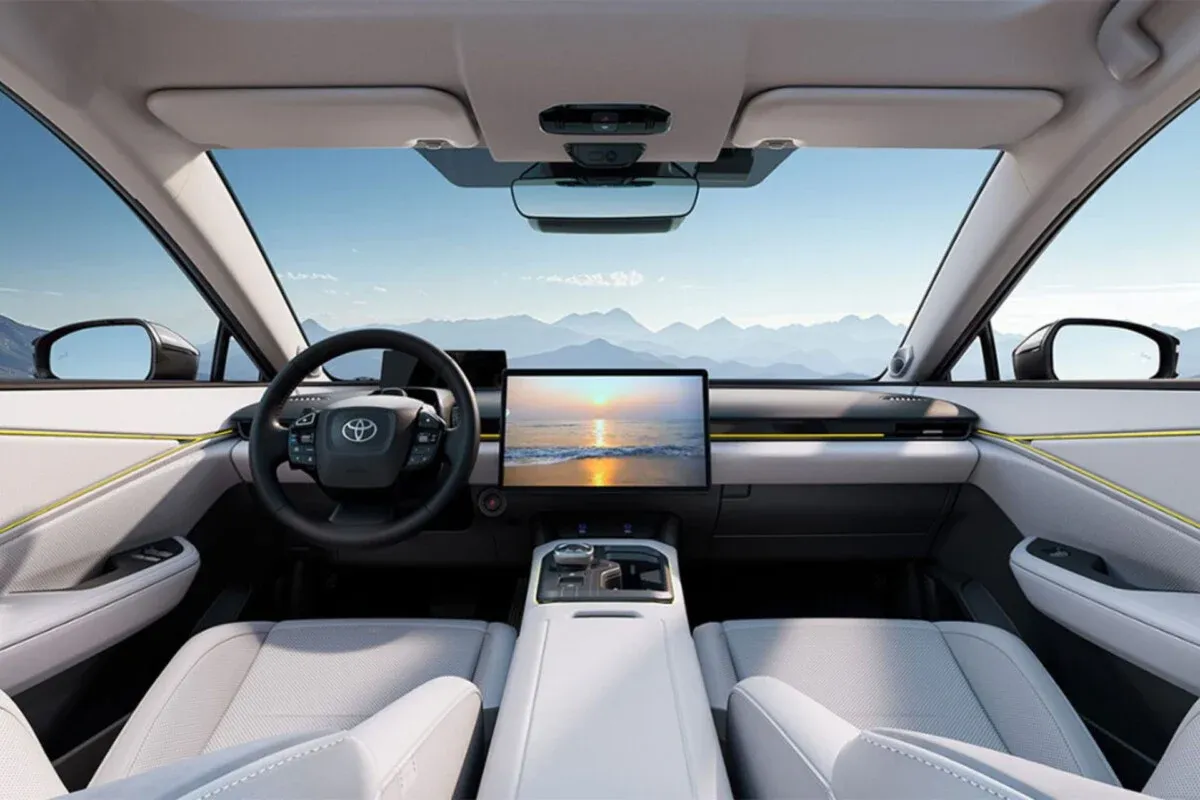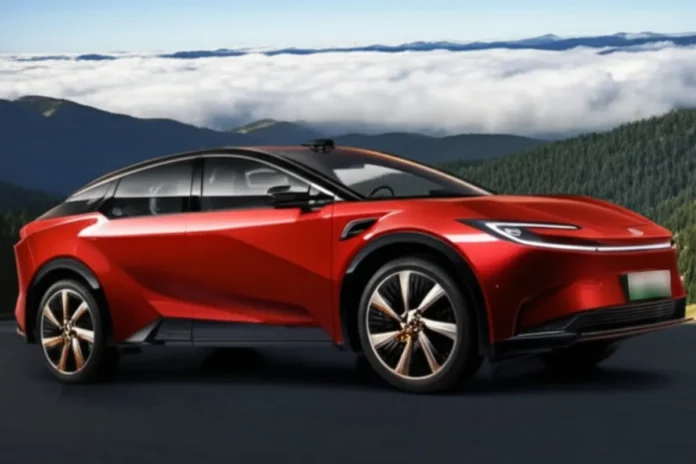Toyota, long known for its hybrid prowess with the iconic Prius, is making bold strides in the electric vehicle (EV) market with its latest offering, the bZ5. Launched in China, this sleek electric crossover, developed in collaboration with Chinese EV giant BYD, blends cutting-edge technology with a design that echoes the Prius’s distinctive aesthetic. This move signals Toyota’s shift toward embracing fully electric vehicles, driven by global demand and regulatory pressures, while leveraging BYD’s expertise in battery technology. Here’s everything you need to know about the Toyota bZ5, a vehicle poised to compete with the likes of Tesla’s Model 3 and BYD’s Seal.
A Design That Turns Heads
The Toyota bZ5 draws immediate comparisons to the Prius, and it’s no accident. Its sleek, aerodynamic silhouette features a sharply angled roofline and a rear window that optimizes airflow, enhancing efficiency. The front showcases Toyota’s signature boomerang-shaped LED headlights, a design cue borrowed from the latest Prius and C-HR models. While the drag coefficient (Cx) remains undisclosed, the bZ5’s streamlined profile suggests a focus on aerodynamic performance, crucial for maximizing range in an electric vehicle.
Built on Toyota’s e-TNGA platform, the bZ5 measures 4.78 meters in length, 1.87 meters in width, and 1.51 meters in height, making it slightly larger than the bZ4X, Toyota’s first global EV. This size positions it as a direct competitor to premium electric sedans like the Tesla Model 3 and Volkswagen ID.7. The vehicle’s sleek proportions and modern design make it a standout in the crowded EV market, blending practicality with visual appeal.

Power and Performance: BYD’s Battery Expertise
At the heart of the bZ5 lies a collaboration with BYD, the world’s leading EV manufacturer by sales. The bZ5 is equipped with BYD’s advanced Blade LFP (lithium-iron-phosphate) batteries, known for their safety, durability, and cost-effectiveness. Available in two capacities—65.28 kWh and 73.84 kWh—the batteries deliver an impressive range of 550 km and 630 km, respectively, under China’s CLTC testing cycle. In the UK, where the WLTP standard applies, these translate to approximately 467 km and 535 km, offering competitive range for long-distance travel.
Charging is another highlight. The bZ5 supports fast charging, capable of reaching 30% to 80% capacity in just 27 minutes at a peak power of 90 kW. While not the fastest in the market, this performance ensures quick top-ups during road trips, making the bZ5 a practical choice for UK drivers navigating the country’s expanding charging infrastructure.
The bZ5 comes in four variants, though specific power outputs remain under wraps. Given Toyota’s partnership with BYD, the vehicle likely features robust electric motors, with performance tailored to balance efficiency and driving dynamics. The collaboration with FAW, a Chinese automotive giant, further underscores the bZ5’s role as a product of global expertise, designed to meet the demands of a competitive market.
Toyota’s Electric Evolution
Toyota’s journey to electrification has been cautious. While the brand pioneered hybrid technology with the Prius in 1997, it has lagged behind competitors like Volkswagen and Tesla in fully electric vehicles. Former CEO Akio Toyoda expressed skepticism about EVs, arguing they may not be as environmentally friendly as claimed. However, under new leadership from Koji Sato, Toyota is pivoting toward electrification, driven by regulatory mandates and consumer demand in markets like China and Europe.
The bZ5 is a testament to this shift. Developed through a joint venture with FAW in China, it joins Toyota’s growing bZ (Beyond Zero) lineup, which includes the bZ4X and bZ3. Unlike its predecessors, the bZ5 combines Toyota’s design heritage with BYD’s cutting-edge battery technology, signaling a more aggressive push into the EV space. This partnership allows Toyota to compete in China’s fiercely competitive EV market, where local brands like BYD dominate.
How the bZ5 Stacks Up
To understand the bZ5’s place in the market, let’s compare it to its key rivals:
| Feature | Toyota bZ5 | Tesla Model 3 | BYD Seal | Volkswagen ID.7 |
|---|---|---|---|---|
| Length | 4.78 m | 4.72 m | 4.80 m | 4.96 m |
| Battery Capacity | 65.28 kWh / 73.84 kWh | 60 kWh / 75 kWh | 61.4 kWh / 82.5 kWh | 77 kWh / 86 kWh |
| Range (WLTP) | 467–535 km | 513–629 km | 520–570 km | 620–700 km |
| Fast Charging | 30–80% in 27 min (90 kW) | 15–80% in 25 min (250 kW) | 30–80% in 26 min (150 kW) | 10–80% in 28 min (175 kW) |
| Starting Price (Est.) | £40,000–£50,000 (TBC) | £39,990 | £45,695 | £55,000 (Est.) |
The bZ5’s range and charging capabilities are competitive, though its charging speed lags behind Tesla’s. Its pricing, while not yet confirmed for the UK, is expected to be in line with premium electric sedans, making it an attractive option for buyers seeking a blend of style, efficiency, and brand reliability.
Why the bZ5 Matters for the UK
For UK drivers, the bZ5 represents an exciting addition to the EV market. Its Prius-inspired design appeals to those familiar with Toyota’s hybrid legacy, while its electric powertrain aligns with the UK’s push toward net-zero emissions. With the government’s ban on new petrol and diesel car sales by 2035, vehicles like the bZ5 are crucial for mainstream adoption of EVs. Its competitive range and fast-charging capabilities make it suitable for both urban commutes and long-distance journeys across the UK’s motorways.
Moreover, Toyota’s partnership with BYD addresses concerns about battery production and sustainability. BYD’s Blade LFP batteries are cobalt-free, reducing environmental impact and reliance on scarce materials. Toyota’s commitment to recycling, as seen in its partnership with Redwood Materials to repurpose Prius batteries, further enhances the bZ5’s eco-credentials.
What’s Next for Toyota’s Electric Future?
The bZ5 is just one piece of Toyota’s ambitious electrification strategy. The company plans to launch 15 electric models by 2027, including a potential electric Land Cruiser and a Hilux EV. While the bZ5 is currently exclusive to China, its success could pave the way for a European launch, potentially reaching UK shores by 2026. Toyota is also investing in solid-state battery technology, which could revolutionize EV range and charging times in the coming years.
For now, the bZ5 showcases Toyota’s ability to blend its design heritage with cutting-edge EV technology. By partnering with BYD, Toyota is not only catching up with competitors but also positioning itself as a serious contender in the global EV market.
Final Thoughts
The Toyota bZ5 is more than just a new electric car—it’s a statement of intent from a brand historically hesitant about EVs. With its Prius-inspired design, BYD’s advanced battery technology, and competitive performance, the bZ5 is poised to make waves in the electric vehicle landscape. While UK availability remains unconfirmed, its blend of style, range, and efficiency makes it a model to watch. As Toyota accelerates its electrification efforts, the bZ5 could mark the beginning of a new era for the Japanese automaker.




